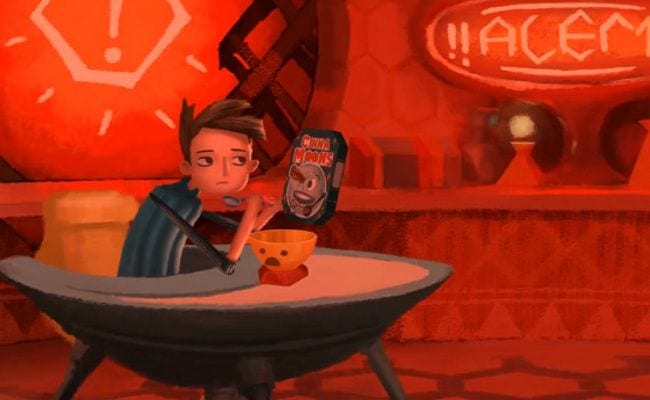The following post contains spoilers for the first part of Broken Age (part 1) and BioShock.
Broken Age is a placid experience compared to many other popular games. As in most point-and-click adventures, action sequences and reflex challenges are minimized in favor of puzzles and conversations with other characters. In many ways, most of what you do is mundane: collect items, combine them in goofy ways, bring them to other characters, and repeat. However, these types of actions fit well with the game’s story of characters rebelling against the banal. Broken Age is about quiet, yet determined struggle against an oppressive status quo.
Broken Age has two main characters, both of whom come to the same narrative point, albeit by different paths. I started with Shay, a young Elijah Wood-looking boy who also happens to be voiced by Elijah Wood. Shay’s life is one of relative comfort and privilege aboard a space station. An AI system provides for all his basic needs, but his life is dull and lonely. His only companionship take the form of the paternal AI units and robotic minions that serve mainly to keep him from doing anything extraordinary. Every day he takes part in contrived adventures that only serve to underscore the complete lack of freedom and spontaneity in his world.
Vella, Broken Age’s other character, also struggles with the status quo of her surroundings. However, her problems are much more immediate. The villages of her world regularly sacrifice young women to a monster that regularly demands tribute. Instead of being horrifying, the violence is institutionalized and accepted as a normal (and even welcome) fact of life by most of Vella’s community. Being eaten by a beast is more than normal; it’s a well-recognized honor akin to winning a beauty pageant or a talent show. In this context, Vella’s refusal to go quietly into the maw of the monster is seen as flat out weird by other villagers. Why refuse the honor of participating in the ritual associated with such a basic, well-established tradition?
Broken Age connects you to these themes through its puzzles. As Shay, you play through his maddeningly condescending missions. Ice cream avalanches, surprise hug attacks, an out of control kiddie roller coaster, all his missions have but one solution and repeat every day. Until you decide to get subversive, you can go through Shay’s dawn to dusk routine and ploddingly click along while he sighs. Vella’s story places you directly in harm’s way, but you spend much of the adventure struggling to make people see the big picture. You help Vella look for a ceremonial knife while her family eagerly awaits the sacrifice. The monster looms out of the sea, but the other villagers are only concerned with what they’ll wear and how the carnival will turn out. You and Vella are continually faced with blasé situations while everyone else around you seemingly ignores the madness.
Through these situations, Broken Age flirts with a criticism of adventure games in general. From Monkey Island to Machinarium, the genre has traditionally been very heavy in producing absurd situations and contrived puzzles. It’s more than a little weird that so many games have you save the day by combining household items or by hunting around for secret panels that trigger Rube Goldberg door opening sequences. Broken Age utilizes these conventions but juxtaposes them against extreme circumstances to drive home the characters’ struggles against the world’s suffocating normalcy.
Because of this, Broken Age walks dangerously close to the BioShock trap. The genius and tragedy of BioShock comes from its great reveal that the main character (and by extension the player) is a hypnotized sleeper agent being tricked into following orders and going on killing sprees. The spell is eventually broken, but the narrative revelation is undercut by several more hours of following in-game instructions and conducting more killing sprees. The moment of freedom is itself an illusion, which means that at best the game is a cynical take on player choice and shooter conventions. Broken Age, like BioShock, is both steeped in genre conventions and focused on telling a story about the consequences of trying to defy your fate.
Broken Age sidesteps the cynicism in BioShock because it’s not criticizing the puzzles themselves, but rather their absurdity in the context of the larger world in which they exist. Shay’s fake space missions and Vella’s arguments about sacrificial fashion tips feel frustratingly pointless in the face of endless inanity or immediate danger. However, once both characters begin to break out of the boring grip of their respective situations, the same simple dialogue trees and simple item combos become subversive acts. Tricking a knitting robot or arguing with an anthropomorphic tree are still silly in a vacuum, but in the broader context of Broken Age they serve to clearly represent the characters’ personal rebellions. In Broken Age, it’s the purpose behind an action rather than the action itself that is important.
By the end of the first episode, Shay and Vella switch sides. Shay finds himself in a world of true danger while Vella enters one of manufactured tranquility. Both have traded their restrictive normal lives for a new, but similarly constrained environment. Being an adventure game, it’s safe to assume that episode two will involve the normal pointing, clicking, and dialogue trees. But as episode one demonstrates, these well-worn actions can be used to tell a larger story about questioning the habits and traditions that constrain us.


![Call for Papers: All Things Reconsidered [MUSIC] May-August 2024](https://www.popmatters.com/wp-content/uploads/2024/04/all-things-reconsidered-call-music-may-2024-720x380.jpg)



